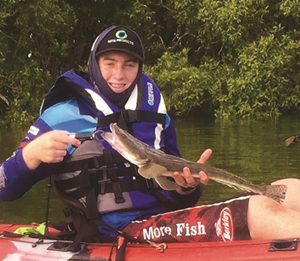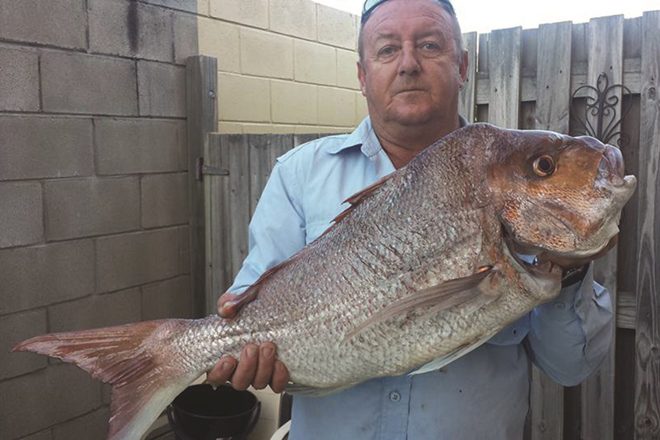
SNAPPER, come on down!
June is an awesome time of year for getting rugged up, grabbing a mate and searching for a feed of snapper. A few spots reasonably easy to access either land-based or by boat or kayak will produce a good feed. Traditionally, we like to start at the mouth of the Brisbane River and work our way back upriver (generally no more than a five to 10-minute leg) until we find little drop-offs or rocky areas.
The only real problem we have had is figuring out what they are eating on the day. Snapper’s diet can change from day to day. One day they will be smashing squid heads and the next day yellowtail fillets and pieces of or whole large prawns. I guess it is a good problem to have, unless it is your turn to buy the bait…
Most of the fishos I talk with swear by getting a berley trail working, be it old prawn shells, leftover pillies and mullet chunks or even pellets mixed with a good grade tuna oil. Berley will unfortunately bring about the ‘rubbish’ fish as well but that is the price you pay for a shot at a cracking snapper. For those new to making berley, a little trick is to add two or three handfuls of sand to the mix before the tuna oil. When mixed, the tuna oil will stick to the sand and when released will disperse the berley scent through the water column (add the sand after the blender!).
Snapper are quite partial to soft plastics and hard-bodied lures, be they trolled or cast. Don’t be afraid to flick out a Z-Man DieZel MinnowZ or Zerek Ripper Diver. Rug up and get out there! Persistence can pay dividends if you take your time and investigate the area well. Arno put cracker fillets on the family table with a 6.1kg snapper caught in the Moreton Bay area on his kayak. Everyone has their own style of attacking new fishing territory and young Tyler Browne has his own idea of what has been working well on his family holidays.
The following advice is from Tyler:
“When I go fishing in an unfamiliar place, I focus on a key point – I must match the hatch. Normally when you arrive at a new fishing spot, you should look for the local bait and what the fish would be feeding on. They could be feeding on fish, crabs, prawns or muscles and barnacles, so whether you use bait or lures, it is crucial you select something that represents the type of food the fish are targeting. Even if you fish a spot regularly and look at the bait the fish are feeding on, you should look even closer and take note of the size and colour of the bait.
The finest detail could be the difference between triggering a strike from a big fish or spooking that big fish. I recently caught my first queenfish, which would not have happened if I didn’t look closely at the bait the fish were feeding on. The little details you observe can catch you anything from whiting to the most finicky bream and nailing the details is one of the best ways to catch more and bigger fish more regularly. When using soft plastics, it is also important to consider the weight of your jig head and where in the water column your target species is lurking.
So, if you are fishing the first 1-1.5m of water you should use an extremely light jig head (1/16oz-1/40oz) so it descends naturally and looks like an injured baitfish. As your lure slowly sinks, a host of species feeding towards the surface will be tempted to relieve you of your favourite lure. When targeting fish holding tight to structure, you want as heavy a leader as possible without spooking the fish (6-10lb). But when you are fishing in an area with less snags and structure, you can go lighter so they cannot see the line (2-6lb). I hope this helps you catch the fish of your dreams.”
Moreton Bay tailor
For those who don’t mind a nice tailor fillet on the table, now is the time to get out there and bag a couple. Good size schools have been seen around the Moreton Bay area from Straddie to Bribie and solid sized tailor have been among them. Dust off the casting gear, sharpen those trebles, salt up some pillies or blue baits and get into these Moreton Bay tailor. I will be keeping an eye on a few spots locally that have produced great catches over the years (and cost me a bit of gear at the same time!).
Nudgee Beach, Shorncliffe through to Brighton, Scarborough and Bribie Island will be on the watch list but Sandgate pool just after dark on a high tide has always been a preferred starting point for the crew. If you have not chased tailor before, keep it simple to start with and grab some 2/0-4/0 gang hooks, a small sinker, a good handful of pillies or blue baits (I prefer salted blue baits), a couple of mates, a Thermos of coffee and of course a couple of Band-Aids.
If tailor are in the area you should have a solid feed before long, but you should also have a good chance of nailing flathead, bream and jewies as by-catch. Like any type of fishing, you just never know what you’re going to go home with!
Wherever you end up, enjoy the time, fish with a mate and most importantly, maintain the passion.
 Bush ‘n Beach Fishing Magazine Location reports & tips for fishing, boating, camping, kayaking, 4WDing in Queensland and Northern NSW
Bush ‘n Beach Fishing Magazine Location reports & tips for fishing, boating, camping, kayaking, 4WDing in Queensland and Northern NSW









